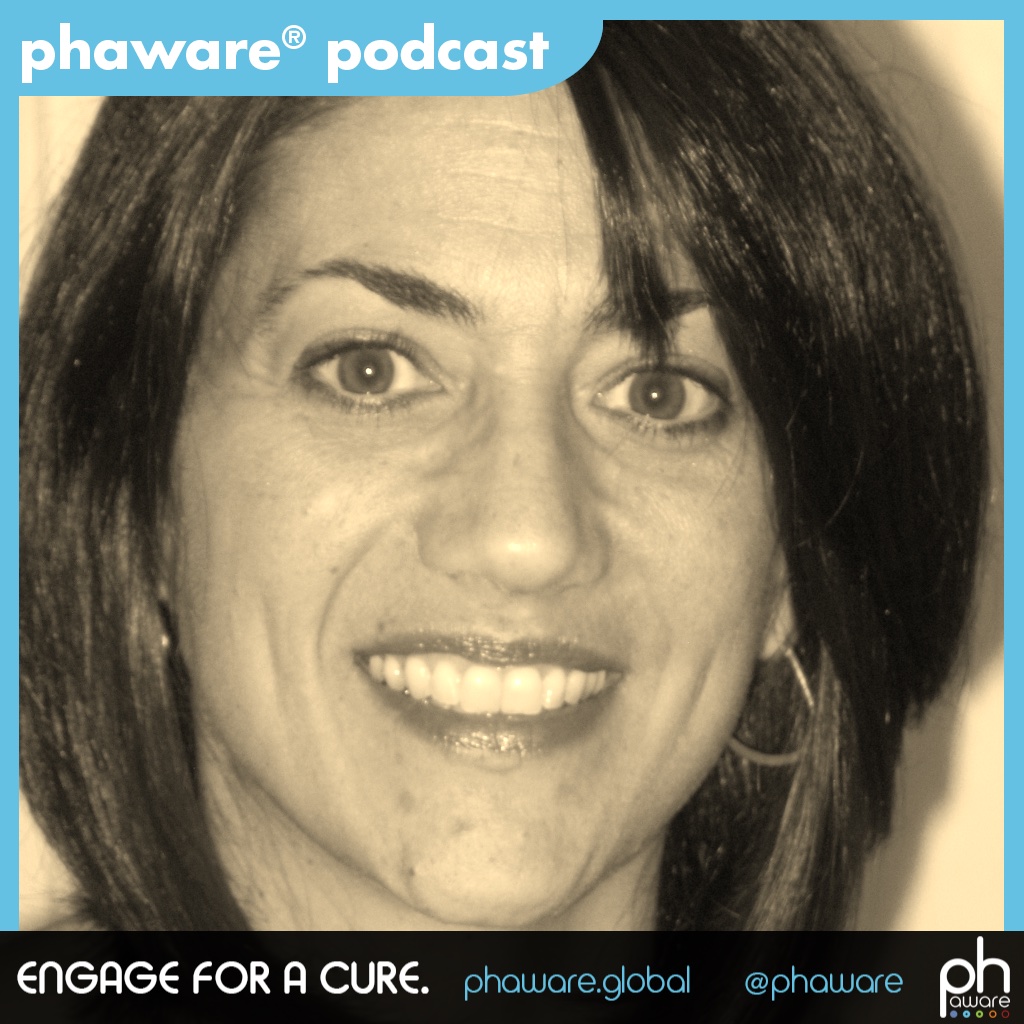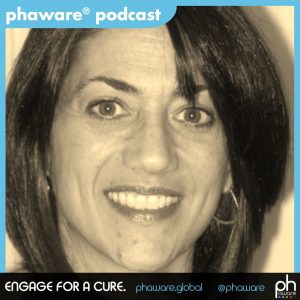Phaware Podcast: Joanne Sperando

This podcast series, created and produced by phaware, is being offered as a regular guest feature on Pulmonary Hypertension News to bring the voices and life experiences of PH patients, family members, caregivers, healthcare specialists, and others to our readers. You may listen to the podcast directly, or read it via the transcript that runs below.
I’m Aware That I’m Rare: Joanne Sperando
The phaware® interview (Episode 106)
Joanne Sperando lives in North Babylon, New York, and was the third person in her family to be diagnosed with pulmonary hypertension (PH). Joanne’s mother lost her 23-year-old sister Josephine to PH in 1963. Joanne’s brother John was diagnosed in 1995 and passed in 2015, and she received her diagnosis in 1998. Joanne formed and currently co-leads a support group, and she served two terms on the board of trustees of the Pulmonary Hypertension Association. Joanne has testified in Washington for PH causes and conducts local fund-raising events to generate funds for PH research.
My name is Joanne Sperando. I am the third person in my family to be diagnosed with pulmonary hypertension.
My mom’s sister was diagnosed and passed away in 1963, it was the year before I was born. My brother was three years old when our Aunt Josie passed. The family essentially forgot the name of the disease as pulmonary hypertension, and my mom just came to remember that Aunt Josie died with an enlarged pulmonary artery. But when my brother was diagnosed in 1995, we looked back to my aunt’s medical records and found that there was indeed a firm diagnosis back then of pulmonary hypertension.
family essentially forgot the name of the disease as pulmonary hypertension, and my mom just came to remember that Aunt Josie died with an enlarged pulmonary artery. But when my brother was diagnosed in 1995, we looked back to my aunt’s medical records and found that there was indeed a firm diagnosis back then of pulmonary hypertension.
My family tried to learn everything they could about pulmonary hypertension. John was offered to participate in a clinical trial for an IV drug. He was very, very sick and entered the clinical trial and did well for 20 years. He passed away in 2015. When John was diagnosed in ’95, I learned all I could about pulmonary hypertension. I read the patient’s survival guide. I began to recognize symptoms in myself in 1998. John took me to his doctor and she tested me and confirmed that I did also have pulmonary hypertension.
Our family got involved very quickly in research that was going on at the hospital. There have been 10 genetic mutations identified by researchers that cause pulmonary hypertension. The mutation that my family has is not one of them. So, we know that there’s another mutation that’s responsible for our PH, but it hasn’t been identified yet.
I entered a clinical trial in 1998 for a subcutaneously delivered medication, and I have been on that medication since then. I think John and I were very lucky, very fortunate, to be diagnosed with pulmonary hypertension and have options. Of course, when John was diagnosed, the only option that he had was this IV drug, which he was very fortunate that it worked. Three years later when I was diagnosed, I had the choice of going on to the same drug that John had taken, or participate in a new trial, and that’s what I did.
I think PH patients, we’ll always have our eyes open for new medications, new delivery systems of those meds. It’s wonderful that patients today have 14 choices, and it’s through clinical trials that we’ve learned so much. It’s difficult to come to a decision to try a drug that hasn’t been tried out yet, and there is certainly a degree of trepidation about side effects and how this is going to affect me. But, I would say that many PH patients are willing to be pioneers.
In our support group, we urge PH patients to seek out care from a PH specialist, be it a cardiologist or a rheumatologist or a pulmonologist. It’s important because our medications are very unique. Pulmonary hypertension is a rare disease and there’s a lot of outside factors that can impact a PH patient. So, we know that patients are going to get the best care from specialists and if they can also afford to get to a PH certified center or hospital, they will get the best care there, and have the most drugs available to them, so that they can manage this illness.
Pulmonary hypertension is a devastating disease to be diagnosed with and one of the reasons for that is that it’s rare and most people can’t identify with it. In 1999, a year after I was diagnosed, I got into contact with some national organizations and found out that there was no local support group here on Long Island in New York. Together with my brother and my family, we formed a local support group and it was wonderful. It was the first time that many patients even met a fellow pulmonary hypertension patient. Friendships sprang up, and the group is still going on and is growing even today.
In January 2016, my PH doctor and I, who have been watching my pulmonary artery grow and grow, I had developed a pulmonary artery aneurism, and it was so severe that it began to pull apart my pulmonary valve. So, although my doctor absolutely did not want me to have open heart surgery, we began to realize that if the artery kept growing, it was in danger of rupturing. So, in January of 2016, I went into the hospital and my doctor hooked me up with a cardiothoracic surgeon who did the surgery and replaced my pulmonary artery with one made of Dacron and replaced my pulmonary valve with a cow valve.
Although the surgery did not go smoothly and I required four trips to the OR and I experienced many complications, I did eventually settle down, my condition stabilized, and I recovered. I was very, very fortunate and came to understand that this was simply a rare side effect of pulmonary hypertension, of long-term pulmonary hypertension, and I was incredibility lucky to be at such a large center and have my doctor coordinating the surgery with a wonderful surgeon who essentially saved my life, because that aneurism would have erupted eventually. I am considering myself incredibly fortunate to still be walking around.
I think one of the most important things for any pulmonary hypertension patient is to be as educated as possible about their illness and about the medications they take. I think it’s important to be a good patient, to arrive on time and work very closely with your doctor in a collaborative way that you two can tackle a complicated life and living with a complicated medical condition like pulmonary hypertension.
When I formed the local support group, I could see that the sharing of information and the creation of friendships and relationships between our members helped people tremendously, and also helped not just the patients, but their family, as their family members and their caregivers were given the opportunity to befriend other folks who were going through the same thing.
The comfort that people derived from being in this community has been one of the greatest joys for me, and I recommend to any PH patient to seek out a local support group and learn as much as you can about pulmonary hypertension.
I’m Joanne Sperando, and I’m aware that I’m rare.
EVERYBODY HAS A STORY. WHAT’S YOURS?
Phaware global association wants to share your pulmonary hypertension story with their engaged global audience. Whether you are a patient, caregiver, or medical professional, they are enlisting PH community members from around the world. Visit www.phawarepodcast.libsyn.com/contact to share your story and to be considered for a future episode. Never miss an episode with the phaware® podcast app. Learn more about pulmonary hypertension at www.phaware.global. #phaware
***
Note: Pulmonary Hypertension News is strictly a news and information website about the disease. It does not provide medical advice, diagnosis, or treatment. This content is not intended to be a substitute for professional medical advice, diagnosis, or treatment. Always seek the advice of your physician or other qualified health provider with any questions you may have regarding a medical condition. Never disregard professional medical advice or delay in seeking it because of something you have read on this website. The opinions expressed in this column are not those of Pulmonary Hypertension News or its parent company, Bionews Services, and are intended to spark discussion about issues pertaining to pulmonary hypertension.










Leave a comment
Fill in the required fields to post. Your email address will not be published.